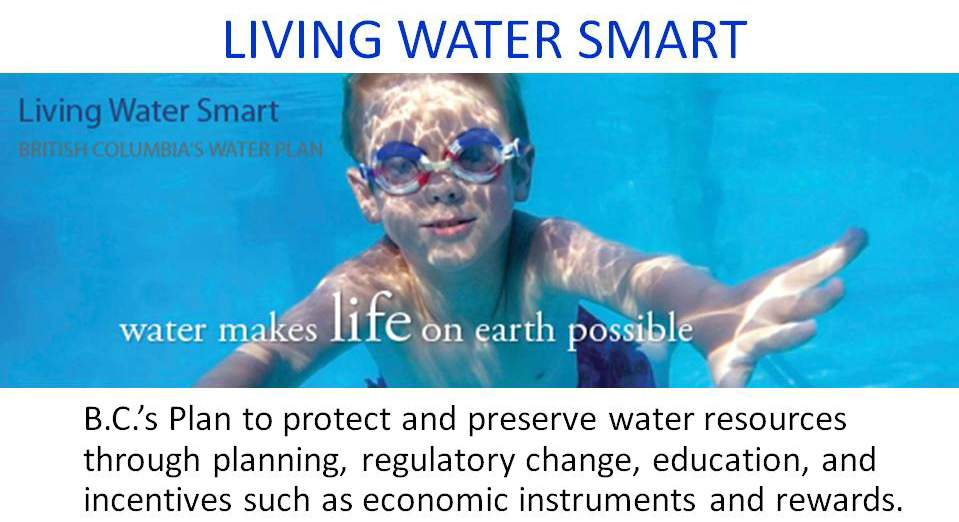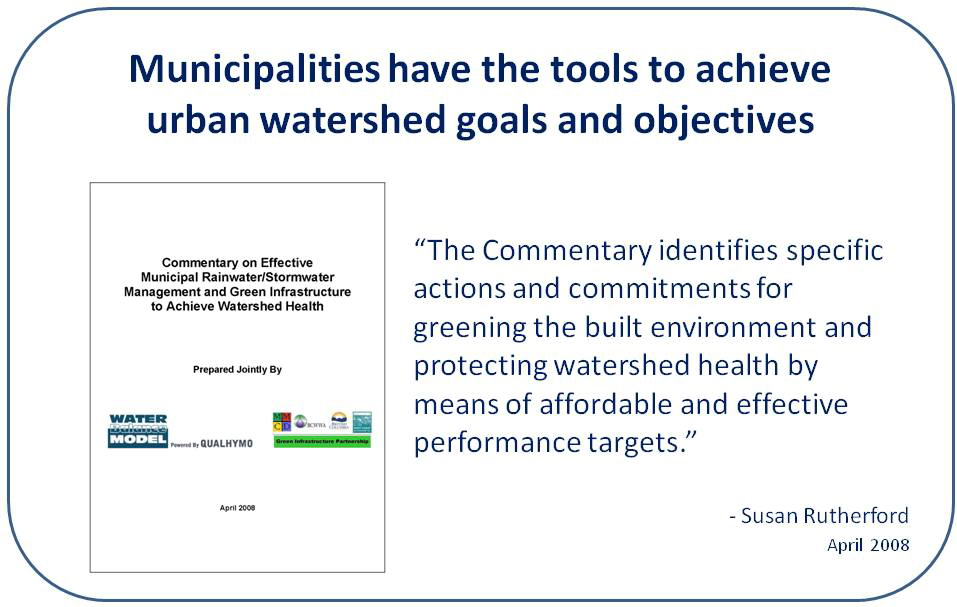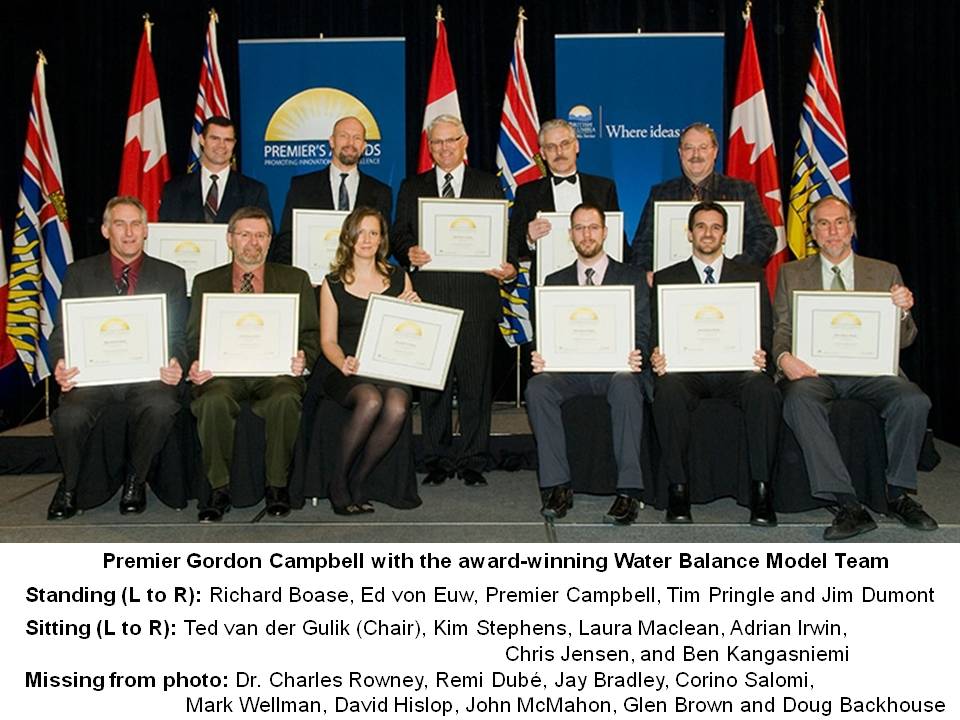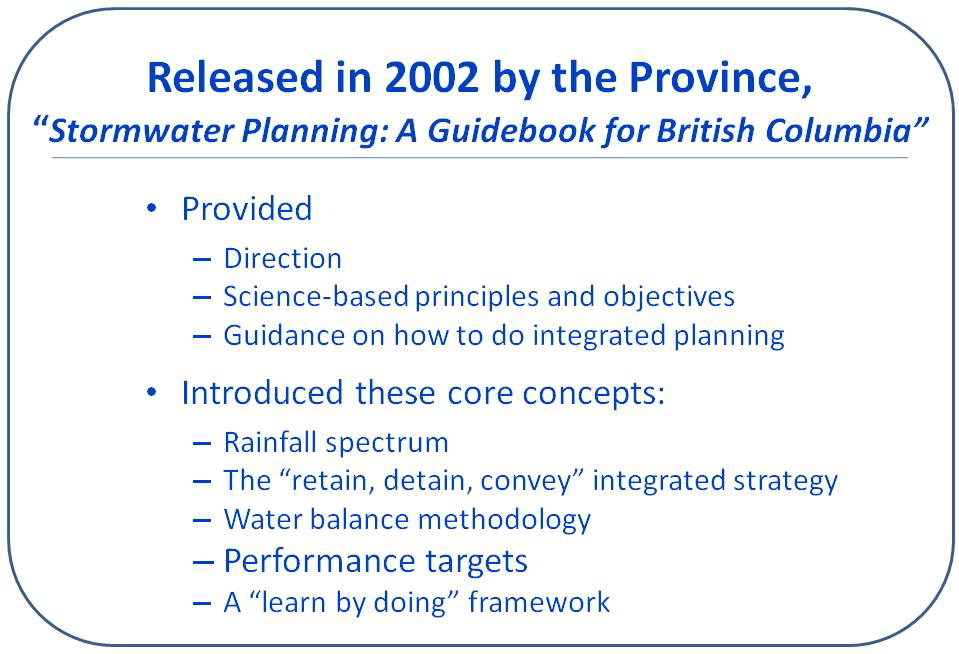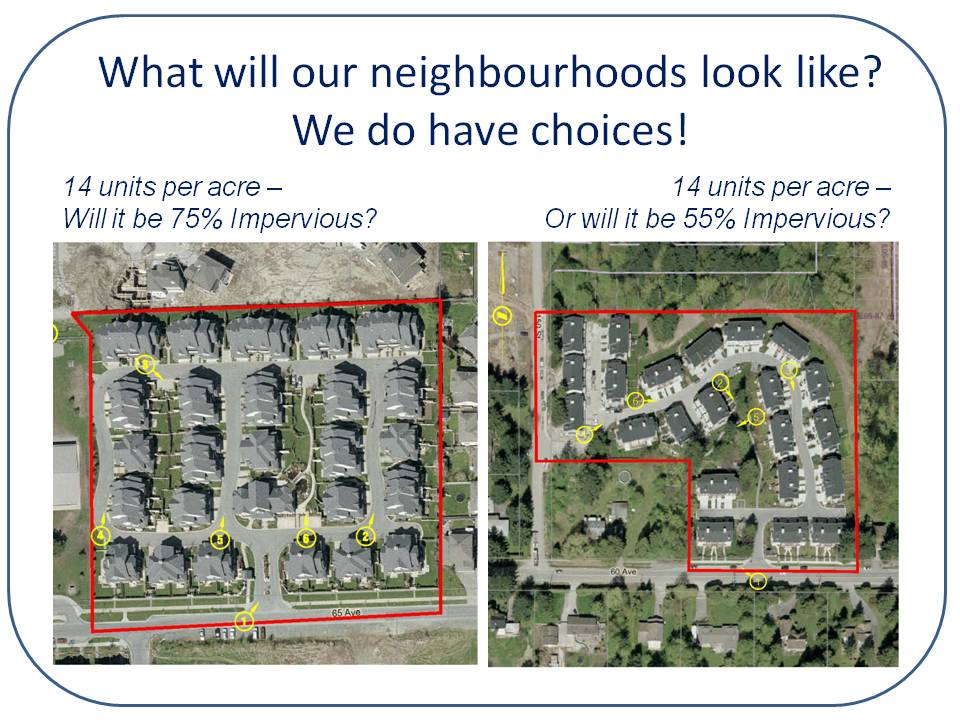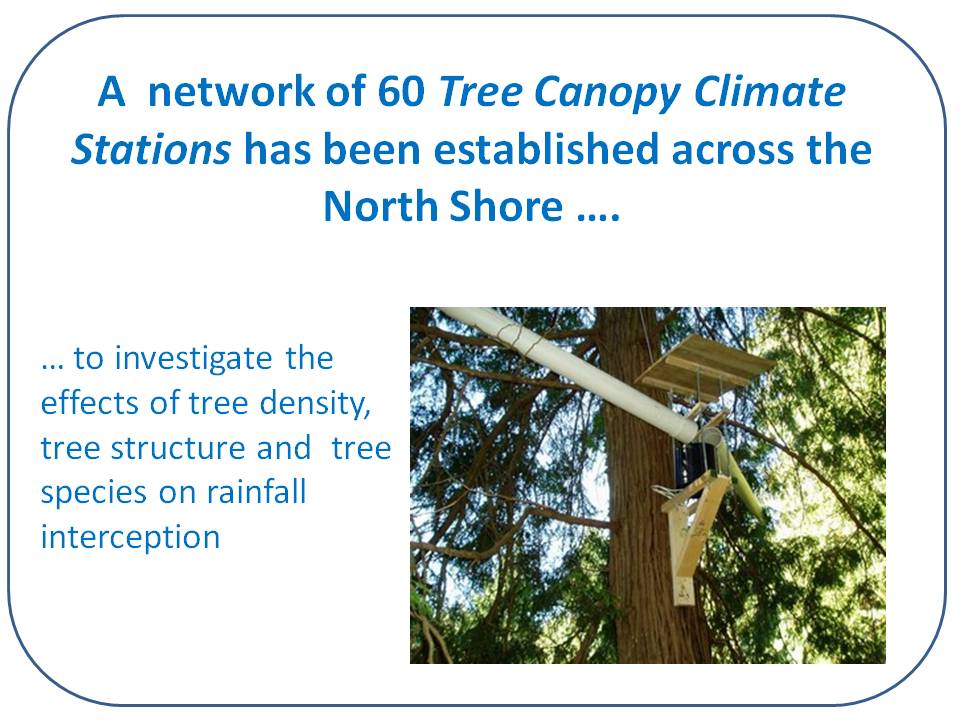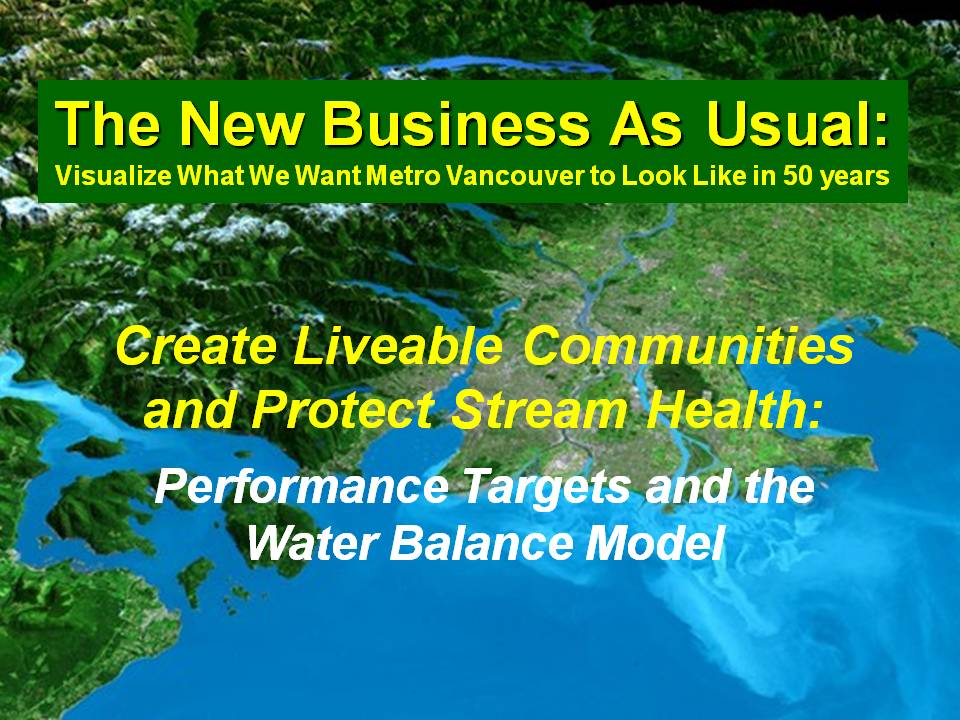SURREY FORUM STORY #4: Making Green Choices: Use the Water Balance Model to Inform Land Development Strategies
Note to Reader:
To download a report-style, PDF version of the following web story about the Surrey Water Balance Model Forum, click on Making Green Choices: Use the Water Balance Model to Inform Land Development Strategies.
The relevance of the following web version resides in the embedded links to other Water Bucket resources that elaborate on various aspects of the Surrey Forum storyline.
The Forum was held in Council Chambers at Surrey City Hall. For an overview of the Agenda, click on Lesson Plan – Draft Outline of What We Want to Achieve.
Convening for Action in the Metro Vancouver Region
How do we simultaneously work together as staff within a municipality and as a region AND externally with developers and other private sector players, to ensure we implement sustainable approaches to development?
The foregoing challenge provides context for advancing a ‘regional team approach’ at the Metro Vancouver Water Balance Model Forum on March 12, 2009. Hosted by the City of Surrey, this learning event is co-sponsored by the Water Balance Model Inter-Governmental Partnership and the Green Infrastructure Partnership.
1. Alignment with Provincial Goals
“The Surrey Forum is designed to achieve multiple objectives in accordance with  the policy framework developed by the Province in Living Water Smart, BC’s Water Plan,” states Ted van der Gulik, Chair of the Inter-Governmental Partnership.
the policy framework developed by the Province in Living Water Smart, BC’s Water Plan,” states Ted van der Gulik, Chair of the Inter-Governmental Partnership.
“In particular, we wish to explore ways that regulators and designers can apply the Water Balance Model to facilitate implementation of green infrastructure solutions that achieve two objectives: create liveable communities and protect stream health.”
The Story of the Surrey Forum
 “This is the fourth in a series of stories leading up to the Forum, explains Kim Stephens, Forum team leader and Program Coordinator for the Water Sustainability Action Plan for British Columbia, “Their purpose is to progressively connect the dots and foreshadow what participants can expect on March 12th.”
“This is the fourth in a series of stories leading up to the Forum, explains Kim Stephens, Forum team leader and Program Coordinator for the Water Sustainability Action Plan for British Columbia, “Their purpose is to progressively connect the dots and foreshadow what participants can expect on March 12th.”
“This Story #4 describes the parts that Jim Dumont and Richard Boase will play in the Water Balance Model segment of the program.”
2. Forum Program – An Overview
The Forum program is built around the HOW question as it pertains to green infrastructure: HOW will the City of Surrey ensure it gets built right; HOW will a consistent regional approach be achieved in Metro Vancouver? The morning and afternoon parts of the program each comprise three modules.
On-Site Rainwater Management
“While the morning session will be specifically about the design and construction details of on-site rainwater management and green infrastructure implementation, there will be a Water Balance Model theme w eaving through the discussion,” states Remi Dubé, Drainage Planning Manager with the City of Surrey.
eaving through the discussion,” states Remi Dubé, Drainage Planning Manager with the City of Surrey.
“The three modules comprising the morning session will cover the history of drainage planning in Surrey; the early lessons learned on the ground in the East Clayton Sustainable Community; and what effective implementation of green infrastructure means in Grandview Heights, South Newton and elsewhere.”
“Experience gained from these projects is reflected in the evolution of the water balance methodology. In the new Water Balance Model, the analyses for volume and flow rate reduction are fully integrated at all scales of application.”
Establishing Performance Targets
“A decade of on-the-ground experience has enabled the City of Surrey to move beyond pilot projects to a broader watershed objectives approach to on-site rainfall capture,” continues Remi Dubé, “As we move forward, the new Drainage By-Law endorsed by Council in 2008 is the tool that will enable the City to establish watershed-specific performance targets for rainwater runoff volume and rate reduction.”
Applying the Water Balance Model:
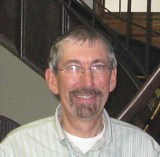 “The Commentary on Effective Municipal Rainwater/Stormwater Management, developed by the Green Infrastructure Partnership in 2008 as part of the updating of Metro Vancouver’s Liquid Waste Management Plan, now takes on added significance and relevance,” states Paul Ham, Past-Chair of the Green Infrastructure Partnership. “The 2-page Commentary is succinct in providing a framework for municipal actions, and for applying the Water Balance Model.”
“The Commentary on Effective Municipal Rainwater/Stormwater Management, developed by the Green Infrastructure Partnership in 2008 as part of the updating of Metro Vancouver’s Liquid Waste Management Plan, now takes on added significance and relevance,” states Paul Ham, Past-Chair of the Green Infrastructure Partnership. “The 2-page Commentary is succinct in providing a framework for municipal actions, and for applying the Water Balance Model.”
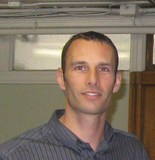 “The morning session will be very much about the nuts-and-bolts of green infrastructure design and construction. This on-the-ground understanding is a prerequisite for an informed discussion in the afternoon about how, and what it means, to apply the Water Balance Model to establish and/or evaluate watershed-specific performance targets for rainfall capture,” adds Corino Salomi, who represents the Department of Fisheries & Oceans on the Green Infrastructure Partnership Steering Committee.
“The morning session will be very much about the nuts-and-bolts of green infrastructure design and construction. This on-the-ground understanding is a prerequisite for an informed discussion in the afternoon about how, and what it means, to apply the Water Balance Model to establish and/or evaluate watershed-specific performance targets for rainfall capture,” adds Corino Salomi, who represents the Department of Fisheries & Oceans on the Green Infrastructure Partnership Steering Committee.
“A must-read guidance document is Beyond the Guidebook: Establish Watershed-Specific Runoff Capture Performance Targets, released in February 2008.”
3. Premier’s Award for Innovation and Excellence
 “The Premier’s Awards are an annual opportunity to publicly recognize the extraordinary accomplishments of the men and women who have chosen public service as their career,” said Premier Gordon Campbell on February 5, 2009 at an awards ceremony where the Water Balance Model received the Premier’s Award for Innovation and Excellence.
“The Premier’s Awards are an annual opportunity to publicly recognize the extraordinary accomplishments of the men and women who have chosen public service as their career,” said Premier Gordon Campbell on February 5, 2009 at an awards ceremony where the Water Balance Model received the Premier’s Award for Innovation and Excellence.
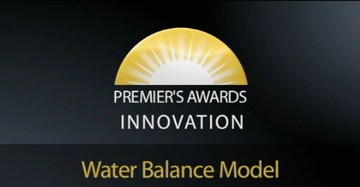
The Story of the Water Balance Model
The Premier’s Office has produced a 2-minute video that features Ted van der Gulik and Kim Stephens telling the story of what the tool means for British Columbia.
“The Water Balance Model is a means to an end,” states Ted van der Gulik. “The challenge that we have been posing since 2002 is this: What do we want this province to look like in 50 years and beyond?“
“The Water Balance Model is a tool that will help us create our future,” adds Kim Stephens. “To get to the big picture, it starts with the smallest pieces. The Water Balance Model links the site to the stream to the watershed.”
To view the video and learn more about “the story of the Water Balance Model”, click on this link to Premier’s Award recognizes the Water Balance Model for its innovation and excellence.
One-on-One with the Premier
At the conclusion of the awards ceremony, the Premier sought out Ted van der Gulik. This created an opportunity for an extended conversation.
“As we talked, it became clear to me that WATER is high on the Premier’s agenda. He has a strong grasp of water-related issues and the long-term implications if we do not start doing business differently in BC. In a nutshell, he gets it.”
 “The Premier expressed his personal commitment to making a difference because we have an obligation and a responsibility to act on behalf of our children and our grand-children so that we leave them with a legacy.”
“The Premier expressed his personal commitment to making a difference because we have an obligation and a responsibility to act on behalf of our children and our grand-children so that we leave them with a legacy.”
“On the matter of the Living Water Smart initiative, I came away from our conversation with a strong conviction that Premier Campbell means what he says, and says what he means about the province-wide importance of implementing BC’s Water Plan. High-level recognition of the Water Balance Model is reassuring… because the model is a key tool underpinning Living Water Smart,” concludes Ted van der Gulik.
 “During the current climate of financial uncertainty, it becomes that much more important to stay on mission vis-à-vis rainwater management and green infrastructure solutions that protect quality of life,” adds Kim Stephens. “In terms of the long-term vision for BC, and as the Premier emphasized in his speech from the heart, now is the time to be preparing for economic recovery that is truly based on making green choices.”
“During the current climate of financial uncertainty, it becomes that much more important to stay on mission vis-à-vis rainwater management and green infrastructure solutions that protect quality of life,” adds Kim Stephens. “In terms of the long-term vision for BC, and as the Premier emphasized in his speech from the heart, now is the time to be preparing for economic recovery that is truly based on making green choices.”
4. Beyond the Guidebook: Connecting the Site to Stream Health
The afternoon part of the Forum program is organized as three modules explains Ted van der Gulik.
“First, we will introduce the provincial policy framework and explain why today’s expectations are tomorrow’s standards (Module 4). Cacading provincial, regional  and local perspectives will be provided by Lynn Kriwoken, Ray Fung and Vincent Lalonde.”
and local perspectives will be provided by Lynn Kriwoken, Ray Fung and Vincent Lalonde.”
“Then Susan Rutherford will lead a town hall sharing session that will explore how regulators, developers and designers can collaborate more effectively, using policy and legal tools to implement green infrastructure solutions (Module 5).”
“Finally, Module 6 is built around a presentation by Jim Dumont and a poster session led by Richard Boase. The information they provide will, in turn, inform a town hall sharing session that explores application of the Water Balance Model to set performance targets for green infrastructure.”
Beyond the Guidebook Introduced
“In 2003, the Inter-Governmental Partnership developed the web-based Water Balance Model as an extension of Stormwater Planning: A Guidebook for British Columbia. Now that we have expanded the decision support capabilities of the Water Balance Model by integrating it with the QUALHYMO hydrologic engine, we have adopted Beyond the Guidebook for branding purposes,” continues Ted van der Gulik.

The pilot for Beyond the Guidebook is the City of Surrey Fergus Creek watershed plan. “The plan is based on implementing green solutions as an alternative to conventional engineered blue solutions,” reports Remi Dubé.
In February 2009, the Ministry of Community Development sent out a Circular to all Municipal and Regional District Chief Administrative Officers, Engineers and Planners regarding the Beyond the Guidebook provincial initiative.
Beyond the Guidebook Explained
Signed by Glen Brown, the purpose of the Beyond the Guidebook Circular is to explain how a number of provincial initiatives support and/or 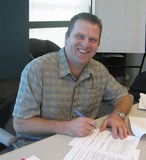 complement each other. Glen Brown is the Executive Director, Local Government Infrastructure and Finance.
complement each other. Glen Brown is the Executive Director, Local Government Infrastructure and Finance.
“We want regional and municipal governments to be informed that the Beyond the Guidebook approach to rainwater management is endorsed by the Province and reflects a ‘design with nature’ approach to climate change adaptation,” states Glen Brown.
Kim Stephens, Stormwater Guidebook project manager and principal author, provides this perspective: “In 2002, the Guidebook introduced the concept of Performance Targets to facilitate implementation of the integrated strategy for managing the complete rainfall spectrum. The 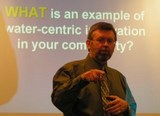 Guidebook made a distinction between Runoff Capture and Rate Control, and emphasized that a combination of the two is necessary for effective rainwater management. It is in addressing the inter-relationship between Runoff Capture and Rate Control that Beyond the Guidebook picks up where the Guidebook left off in 2002.”
Guidebook made a distinction between Runoff Capture and Rate Control, and emphasized that a combination of the two is necessary for effective rainwater management. It is in addressing the inter-relationship between Runoff Capture and Rate Control that Beyond the Guidebook picks up where the Guidebook left off in 2002.”
 “The Beyond the Guidebook methodology enables us to correlate green infrastructure effectiveness in protecting stream health,” explains Jim Dumont, Engineering Applications Authority for the Inter-Governmental Partnership. “The reason is that rainwater runoff volume management is directly linked to stream erosion and water quality.”
“The Beyond the Guidebook methodology enables us to correlate green infrastructure effectiveness in protecting stream health,” explains Jim Dumont, Engineering Applications Authority for the Inter-Governmental Partnership. “The reason is that rainwater runoff volume management is directly linked to stream erosion and water quality.”
Adapting the Surrey Experience
Looking back, application of the water balance methodology to East Clayton can now be seen as the genesis for the Beyond the Guidebook methodology. “With hindsight, the significance of East Clayton is two-fold. It was an early application of performance targets at a neighbourhood scale. Also, and most importantly the analysis combined mass balance and flow duration to test the achievability of performance targets,” continues Jim Dumont.
“But it was the South Newton case study where the methodology really came together in terms of how to integrate the mass balance and stream erosion analyses. Until then, they were separate analyses.”
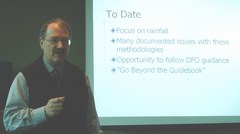 “In South Newton, we were able to demonstrate that distributed rainwater infiltration systems could result in a multi-million dollar net reduction in the City’s 10-Year Capital Plan, while enabling development to proceed. The saving results from elimination of a number of detention ponds.”
“In South Newton, we were able to demonstrate that distributed rainwater infiltration systems could result in a multi-million dollar net reduction in the City’s 10-Year Capital Plan, while enabling development to proceed. The saving results from elimination of a number of detention ponds.”
 “The experience gained in East Clayton and South Newton was then applied in Fergus Creek. The Beyond the Guidebook methodology was formalized as the Stream Health Methodology, and subsequently incorporated in the Water Balance Model when it was integrated with the QUALHYMO engine. The Stream Health Methodology is a function of flow duration, and hence stream erosion,” concludes Jim Dumont.
“The experience gained in East Clayton and South Newton was then applied in Fergus Creek. The Beyond the Guidebook methodology was formalized as the Stream Health Methodology, and subsequently incorporated in the Water Balance Model when it was integrated with the QUALHYMO engine. The Stream Health Methodology is a function of flow duration, and hence stream erosion,” concludes Jim Dumont.
5. Informing Land Development Strategies
 “In Module 6, Jim Dumont will illustrate how the Water Balance Model can be applied to improve land use decision-making,” states Raymond Fung, Chair of the Green Infrastructure Partnership. “He will NOT be doing a hands-on tutorial about model inputs and outputs. Rather, he will be providing an overview of where we are and how we got here.”
“In Module 6, Jim Dumont will illustrate how the Water Balance Model can be applied to improve land use decision-making,” states Raymond Fung, Chair of the Green Infrastructure Partnership. “He will NOT be doing a hands-on tutorial about model inputs and outputs. Rather, he will be providing an overview of where we are and how we got here.”
“Our knowledge is increasing as we gain a better understanding of physical processes and interconnections,” continues Jim Dumont. “A key message is that we can adapt our guiding framework to reflect our understanding.
 “Historically, engineers have typically been called in after the fact to solve drainage problems resulting from land development activities that ignored the water balance. Beyond the Guidebook is about developing land differently so that we can prevent rainwater runoff volume from impacting on streams.”
“Historically, engineers have typically been called in after the fact to solve drainage problems resulting from land development activities that ignored the water balance. Beyond the Guidebook is about developing land differently so that we can prevent rainwater runoff volume from impacting on streams.”
What Will Our Neighbourhoods Look Like?
“When we develop or redevelop land, our starting point should be: What do we want our neighbourhoods look like? The built-form influences how much rainwater runoff volume is generated; and it determines what our options may be for capturing rain where it falls. So we need to look at ways to provide more green 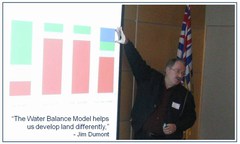 space that can serve more than one purpose,” states Jim Dumont.
space that can serve more than one purpose,” states Jim Dumont.
“On March 12th, we will present a number of examples to illustrate what can be accomplished by developing land differently. We will show that we can in fact achieve our two desired outcomes, namely: create liveable communities and protect stream health. The examples will compare and contrast density versus hardscape.”
“A key message is that you can only do so much infiltration on a small lot. This means we have to be looking at ‘green streets’ and multi-use greenways to achieve watershed-specific performance targets for rainwater runoff volume and rate reduction,” concludes Jim Dumont.
Poster Session with Richard Boase
“To hold the attention of the Forum audience, and have a high-energy finish, we have something different planned for Module 6,” states Kim Stephens. “We will make it worthwhile to stay until the end.”
 “Richard Boase of North Vancouver District will lead a poster session that should be quite stimulating. Richard will have a selection of photos and images mounted on poster boards to generate ideas and discussion. This will create the town hall sharing.”
“Richard Boase of North Vancouver District will lead a poster session that should be quite stimulating. Richard will have a selection of photos and images mounted on poster boards to generate ideas and discussion. This will create the town hall sharing.”
“The focus of the poster session will be on what one can do at the site scale,” adds Richard Boase. “My objective is to demonstrate ‘design with nature’ opportunities that are easy to implement. The poster session will be totally interactive and completely spontaneous.”
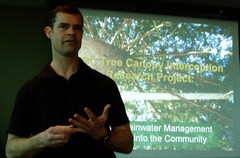 “This will not be a PowerPoint presentation. Rather, I will be saying: Let’s have a conversation about this picture; so, what goes through your mind when you look at this image?”
“This will not be a PowerPoint presentation. Rather, I will be saying: Let’s have a conversation about this picture; so, what goes through your mind when you look at this image?”
“In addition to poster boards, I will be bringing one of the climate stations that we are using for the UBC Tree Canopy Interception Research Project. Sixty are installed in trees across the three North Shore municipalities. I will also be demonstrating how water moves through soil.”
6. Regional Team Approach
“In holding the Surrey Forum, our vision is that this event will be the catalyst for  additional regional forums that would be organized in collaboration with Metro Vancouver’s Stormwater Interagency Liaison Group…. i.e. SILG,” states Ted van der Gulik. “One of our goals is to implement an educational program that would be modelled on the 2008 Vancouver Island Learning Lunch Seminar Series.”
additional regional forums that would be organized in collaboration with Metro Vancouver’s Stormwater Interagency Liaison Group…. i.e. SILG,” states Ted van der Gulik. “One of our goals is to implement an educational program that would be modelled on the 2008 Vancouver Island Learning Lunch Seminar Series.”
Liquid Waste Management Plan
“Metro Vancouver’s Liquid Waste Management Plan is the appropriate vehicle for bringing the desired collaboration to fruition,” adds Kim Stephens. He represents 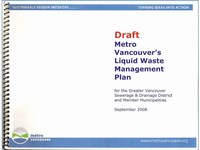 the Water Sustainability Action Plan on the Metro Vancouver LWMP Reference Panel, an advisory group that was appointed by the Metro Vancouver Regional Board in April 2008 and reports directly to the Metro Vancouver Waste Management Committee.
the Water Sustainability Action Plan on the Metro Vancouver LWMP Reference Panel, an advisory group that was appointed by the Metro Vancouver Regional Board in April 2008 and reports directly to the Metro Vancouver Waste Management Committee.
The mandate of the Reference Panel is to provide comments and advice on the strategies for updating the Liquid Waste Management Plan. In its July 2008 reporting out to the Metro Vancouver Waste Management Committee, the Reference Panel raised questions about the Integrated Stormwater Management Plan (ISMP) process and outcomes to date. The Reference Panel also brought this matter to the attention of the Regional Engineers Advisory Committee (REAC) in a February 2009 meeting.
A Model for Integration
 “A significant contribution by the Reference Panel was the suggestion to organize and communicate the Liquid Waste Management Plan around four theme areas,” reports Kim Stephens. “The Reference Panel then applied a Venn diagram way-of-thinking to conceptualize integration. The regional team approach to rainwater management and green infrastructure falls within the Built Environment theme area.”
“A significant contribution by the Reference Panel was the suggestion to organize and communicate the Liquid Waste Management Plan around four theme areas,” reports Kim Stephens. “The Reference Panel then applied a Venn diagram way-of-thinking to conceptualize integration. The regional team approach to rainwater management and green infrastructure falls within the Built Environment theme area.”
“The LWMP comprises eight strategies to achieve two over-arching goal; it also identifies actions to be led by SILG under four of those strategies. The LWMP specifically references collaboration with the Green Infrastructure Partnership and the Water Balance Model partnership to facilitate on-site rainwater management and promote innovative approaches to sustainable infrastructure,” summarizes Kim Stephens.
 “High-level endorsement of the Draft LWMP by Metro Vancouver municipalities creates the opportunity to build on the momentum that we believe will be generated by the Surrey Forum, and to further align local actions under a regional team framework,” concludes Ray Fung, Chair of the Green Infrastructure Partnership.
“High-level endorsement of the Draft LWMP by Metro Vancouver municipalities creates the opportunity to build on the momentum that we believe will be generated by the Surrey Forum, and to further align local actions under a regional team framework,” concludes Ray Fung, Chair of the Green Infrastructure Partnership.
Posted February 2009




